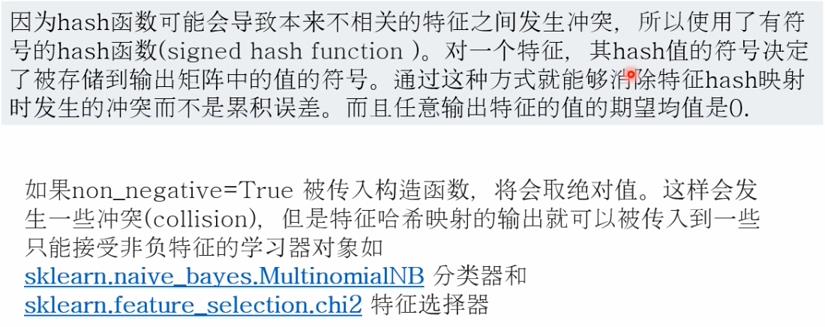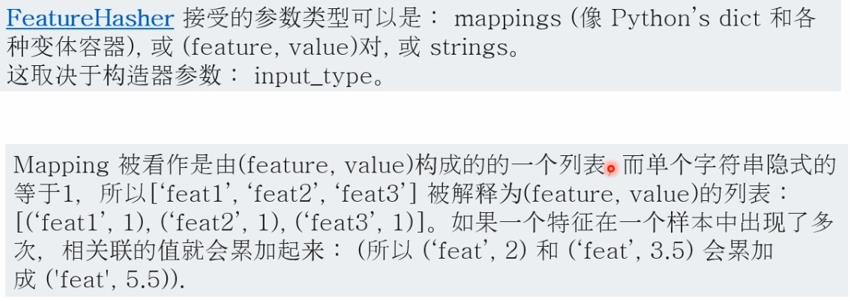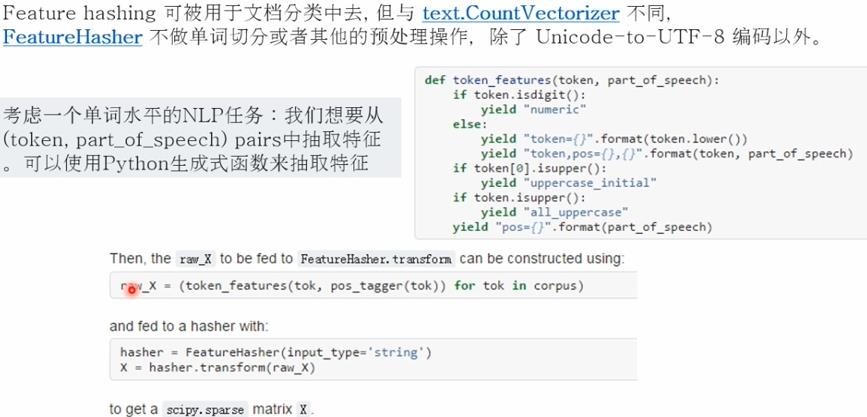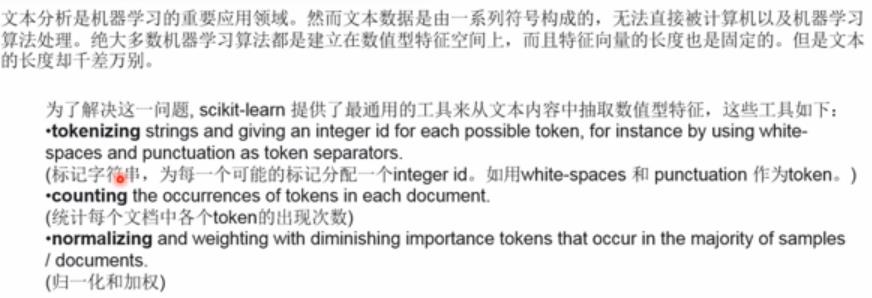sklearn数据变化
Posted nolonely
tags:
篇首语:本文由小常识网(cha138.com)小编为大家整理,主要介绍了sklearn数据变化相关的知识,希望对你有一定的参考价值。
特征抽取sklearn.feature_extraction 模块提供了从原始数据如文本,图像等众抽取能够被机器学习算法直接处理的特征向量。

1.特征抽取方法之 Loading Features from Dicts


measurements=[ {\'city\':\'Dubai\',\'temperature\':33.}, {\'city\':\'London\',\'temperature\':12.}, {\'city\':\'San Fransisco\',\'temperature\':18.}, ] from sklearn.feature_extraction import DictVectorizer vec=DictVectorizer() print(vec.fit_transform(measurements).toarray()) print(vec.get_feature_names()) #[[ 1. 0. 0. 33.] #[ 0. 1. 0. 12.] #[ 0. 0. 1. 18.]] #[\'city=Dubai\', \'city=London\', \'city=San Fransisco\', \'temperature\']
2.特征抽取方法之 Features hashing




3.特征抽取方法之 Text Feature Extraction
词袋模型 the bag of words represenatation



#词袋模型 from sklearn.feature_extraction.text import CountVectorizer #查看默认的参数 vectorizer=CountVectorizer(min_df=1) print(vectorizer) """ CountVectorizer(analyzer=\'word\', binary=False, decode_error=\'strict\', dtype=<class \'numpy.int64\'>, encoding=\'utf-8\', input=\'content\', lowercase=True, max_df=1.0, max_features=None, min_df=1, ngram_range=(1, 1), preprocessor=None, stop_words=None, strip_accents=None, token_pattern=\'(?u)\\\\b\\\\w\\\\w+\\\\b\', tokenizer=None, vocabulary=None) """ corpus=["this is the first document.", "this is the second second document.", "and the third one.", "Is this the first document?"] x=vectorizer.fit_transform(corpus) print(x) """ (0, 1) 1 (0, 2) 1 (0, 6) 1 (0, 3) 1 (0, 8) 1 (1, 5) 2 (1, 1) 1 (1, 6) 1 (1, 3) 1 (1, 8) 1 (2, 4) 1 (2, 7) 1 (2, 0) 1 (2, 6) 1 (3, 1) 1 (3, 2) 1 (3, 6) 1 (3, 3) 1 (3, 8) 1 """
默认是可以识别的字符串至少为2个字符
analyze=vectorizer.build_analyzer() print(analyze("this is a document to anzlyze.")==
(["this","is","document","to","anzlyze"])) #True
在fit阶段被analyser发现的每一个词语都会被分配一个独特的整形索引,该索引对应于特征向量矩阵中的一列
print(vectorizer.get_feature_names()==( ["and","document","first","is","one","second","the","third","this"] )) #True print(x.toarray()) """ [[0 1 1 1 0 0 1 0 1] [0 1 0 1 0 2 1 0 1] [1 0 0 0 1 0 1 1 0] [0 1 1 1 0 0 1 0 1]] """
获取属性
print(vectorizer.vocabulary_.get(\'document\')) #1
对于一些没有出现过的字或者字符,则会显示为0
vectorizer.transform(["somthing completely new."]).toarray() """ [[0 1 1 1 0 0 1 0 1] [0 1 0 1 0 2 1 0 1] [1 0 0 0 1 0 1 1 0] [0 1 1 1 0 0 1 0 1]] """
在上边的语料库中,第一个和最后一个单词是一模一样的,只是顺序不一样,他们会被编码成相同的特征向量,所以词袋表示法会丢失了单词顺序的前后相关性信息,为了保持某些局部的顺序性,可以抽取2个词和一个词
bigram_vectorizer=CountVectorizer(ngram_range=(1,2),token_pattern=r"\\b\\w+\\b",min_df=1) analyze=bigram_vectorizer.build_analyzer() print(analyze("Bi-grams are cool!")==([\'Bi\',\'grams\',\'are\',\'cool\',\'Bi grams\', \'grams are\',\'are cool\'])) #True x_2=bigram_vectorizer.fit_transform(corpus).toarray() print(x_2) """ [[0 0 1 1 1 1 1 0 0 0 0 0 1 1 0 0 0 0 1 1 0] [0 0 1 0 0 1 1 0 0 2 1 1 1 0 1 0 0 0 1 1 0] [1 1 0 0 0 0 0 0 1 0 0 0 1 0 0 1 1 1 0 0 0] [0 0 1 1 1 1 0 1 0 0 0 0 1 1 0 0 0 0 1 0 1]] """
以上是关于sklearn数据变化的主要内容,如果未能解决你的问题,请参考以下文章